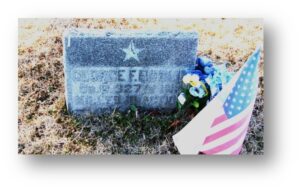Name: Bublin, John F, PVT, USA
Address: Jackson Street (per 1910 census), Main Street (1917 draft record), Matawan, NJ
George was the fifth of nine children of Franz “Frank” Bublin (1860-1940) and Anna Marie Schneider (1867-1944), born May 13, 1894, in Morristown, NJ. Father Frank and his wife and the first three children arrived in the United States on April 9, 1891. (Of interest is the fact that third child, Elizabeth, married William Carney in Matawan in 1912. William was the brother of James Carney, who went to France with the 311th Infantry Regiment and died of the Spanish Flu there in 1919.)
The Bublin family was in Matawan per the 1910 census residing on Jackson Street. The two youngest children were in the Matawan school system per newspaper articles between 1910 and 1915, after which the family relocated to Red Bank, with George appearing in the 1915 census there with the family. He was back in Matawan per his 1917 draft registration, however, which indicated he resided somewhere on Main Street.
Little is known regarding George’s time in Matawan. His draft record of June 5, 1917 indicated he was 6’ tall, medium build with brown hair and eyes, working for Frank Anderson at a lumberyard. An article a month earlier indicated he was working as a gateman at the Oakland Street railroad crossing and would soon be moving to Red Bank.
On August 10, 1917, he was drafted into the army and the record indicated he was from Matawan. On September 22, 1917, he reported to Camp Dix for training. Assigned to Company “C” of the 327th Infantry Regiment, he shipped out to Europe aboard the SS Baltic from New York on April 25, 1918 – odds are his large family was at the pier to see him off.
 The 327th was part of the 164th Infantry Brigade attached to the 82nd Infantry Division out of Fort Gordon, GA. It participated in the opening offensive of the American Expeditionary Force (AEF) in the St. Mihiel Offensive, and then took part in the final push to end the war, the great Meuse-Argonne offensive. During the historic flank attack which eventually pierced the formidable Kriemhilde Stellung defensive position, George was killed in action on October 10, 1918. On that day, the division was fighting south of the villages of Chevieres and Sommerance in France’s Ardennes Department.
The 327th was part of the 164th Infantry Brigade attached to the 82nd Infantry Division out of Fort Gordon, GA. It participated in the opening offensive of the American Expeditionary Force (AEF) in the St. Mihiel Offensive, and then took part in the final push to end the war, the great Meuse-Argonne offensive. During the historic flank attack which eventually pierced the formidable Kriemhilde Stellung defensive position, George was killed in action on October 10, 1918. On that day, the division was fighting south of the villages of Chevieres and Sommerance in France’s Ardennes Department.
Initially buried in an isolated grave in the Chatel Cemetery in the Ardennes, has body was transferred to the large American Cemetery in Romagne. On August 8, 1921, it was again disinterred and placed on the transport USAT Wheaton with 2623 other bodies of servicemen to be returned to the US. It sailed on September 20, 1921, arriving back in Hoboken on October 3rd. After a funeral at St. James Church in Red Bank, George was buried in Middletown’s Mt. Olivet Cemetery. The burial was conducted with full military honors.


NO COMMENTS